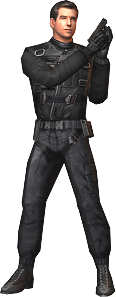 |
| |
MI6 takes a retrospective look behind the
scenes of "NightFire", the first 007 videogame to
feature a
James Bond actor's likeness...
|
|
The Making of 007: NightFire (1)
31st December 2006
MI6 takes a retrospective look behind the scenes of the first
console game to feature a James Bond actor's likeness in this
exclusive multi-part special feature.
Whilst most Bond fans were focusing
on the latest Bond film " Die
Another Day" that was in production during
2002, Electronic Arts were busy completing their second "next
generation" 007 videogame. Thanks by in large to the
huge success of their first multi-platform adventure " 007:
Agent Under Fire", EA's " 007:
NightFire" hit
the ground running and secured the services of the current
occupant of the famous tuxedo - Pierce
Brosnan. |
|
 |

|
|
The game had been under development
well before "Agent Under Fire" shipped for PlayStation
2 in November 2001, but it was rather late in the story
when Brosnan was signed to provide his likeness to the
digital
007.
"NightFire" was developed in
two key parts: Eurocom Entertainment Software in England
developed the first-person perspective shooting engine,
whilst EA's Vancouver and Redwood Shores studios developed
the vehicle-based missions. To link these two genres together,
and to keep the story flowing, cinematics and sound production
were delivered by a team spread across Los Angeles to Toronto.
The entire production was coordinated from EA's headquarters
in California.
EA began production on "NightFire" in
September 2000 (under the working-title "Phoenix Rising"),
and off the back of Brosnan's box-office success in the
1999 film "The World
Is Not Enough", it was decided
to tie their second game to the 20th film - both to be
released in November 2002. Unfortunately as events would
later unfold, almost all plans to link the game and film
would be missing from the player's viewpoint, but two key
elements would remain. |
In July 2002, whilst shooting pick-up shots
for "Die Another Day", Pierce Brosnan was "cyber
scanned" for his inclusion in the game. EA shipped a laser
digitizer to Pinewood Studios to produce a polygon mesh of Brosnan's
head, comprised of almost three-quarters of a million polygons.
This digital model was then tweaked and refined by 3D modellers,
who produced the final character as seen in the game.
Brosnan's collaboration on the game was officially
announced on July 18th 2002, when Chip Lange from EA said: "Pierce
Brosnan and Bond have created an unbeatable combination for the
franchise over the
past few years, so we`re excited to have Pierce aboard to help
deliver to fans the ultimate Bond experience. I am confident
that together, Pierce Brosnan, EA and NightFire will make for
the most dynamic and appealing Bond game yet."
It was in in March 2003, months
after the game was released, that Scot Bayless, who oversaw the
Bond franchise
at
EA, said that they only asked Pierce Brosnan
to undergo a few minutes of digital facial scanning for "NightFire".
Bayless revealed that they did not push the star to do
any voice recording or character movements
for "NightFire",
but said that next time they hoped he would agree to do more (Brosnan
would go on to provide both his voice and likeness for Bond in
2004's "Everything Or Nothing").
The other major element taken from "Die Another Day" and
included in the game was Bond's new set of wheels - the Aston
Martin V12 Vanquish. Working closely with MGM and Danjaq,
EA were allowed to use Bond's latest car in new ways, with
an original game storyline utilising the vehicle's key features.
One of the most iconic moments from the game turns the
Vanquish into a submarine - a homage to the famous Lotus
Esprit from
1977's "The Spy Who Loved
Me". |
|
 |
Whilst the modellers and artists were finalising
the look of the game, in August 2002 - just three months before
the game
shipped - programmers were integrating a new particle system
in to the Nintendo GameCube version. Despite the superior hardware
contained within the PlayStation 2 and Xbox, early previews of
the game praised the GameCube's visuals with rich colourful
environments and smooth polygon edges thanks to the in-built
anti-aliasing toolset.
Stay tuned to MI6 for more from behind the scenes
of "007: NightFire".
Related Articles
 NightFire
NightFire